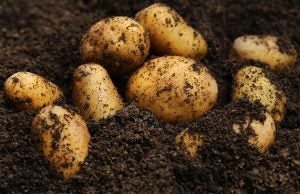Manipulating RNA can allow plants to yield dramatically more crops, as well as increasing drought tolerance, according to research published in Nature Biotechnology.
A group of scientists from the University of Chicago, Peking University, and Guizhou University said that, in initial field tests, adding a gene encoding for a protein called FTO to both rice and potato plants increased their yield by 50 percent. The plants grew significantly larger, produced longer root systems and were better able to tolerate drought stress. Analysis also showed that the plants had increased their rate of photosynthesis.
“The change really is dramatic,” said University of Chicago Professor Chuan He, who together with Guifang Jia at Peking University, led the research. “What’s more, it worked with almost every type of plant we tried it with so far, and it’s a very simple modification to make.”
The researchers are hopeful about the potential of this breakthrough, especially in the face of climate change and other pressures on crop systems worldwide.
“This really provides the possibility of engineering plants to potentially improve the ecosystem as global warming proceeds,” said He, who is the John T. Wilson Distinguished Service Professor of Chemistry, Biochemistry and Molecular Biology. “We rely on plants for many, many things — everything from wood, food, and medicine, to flowers and oil–and this potentially offers a way to increase the stock material we can get from most plants.”

Rice nudged along
For decades, scientists have been working to boost crop production in the face of an increasingly unstable climate and a growing global population. But such processes are usually complicated, and often result only in incremental changes.
The way this discovery came about was quite different.
Many of us remember RNA from high school biology, where we were taught that the RNA molecule reads DNA, then makes proteins to carry out tasks. But in 2011, He’s lab opened an entire new field of research by discovering the keys to a different way that genes are expressed in mammals. It turns out that RNA doesn’t simply read the DNA blueprint and carry it out blindly; the cell itself can also regulate which parts of the blueprint get expressed. It does so by placing chemical markers onto RNA to modulate which proteins are made and how many.
He and his colleagues immediately realized that this had major implications for biology. Since then, his team and others around the world have been trying to flesh out our understanding of the process and what it affects in animals, plants and different human diseases; for example, He is a co-founder of a biotech company now developing new anti-cancer medicines based on targeting RNA modification proteins.
He and Guifang Jia, a former UChicago postdoctoral researcher who is now an associate professor at Peking University, began to wonder how it affected plant biology.
They focused on a protein called FTO, the first known protein that erases chemical marks on RNA, which Jia found as a postdoctoral researcher in He’s group at UChicago. The scientists knew it worked on RNA to affect cell growth in humans and other animals, so they tried inserting the gene for it into rice plants–and then watched in amazement as the plants took off.
“I think right then was when all of us realized we were doing something special,” He said.
The rice plants grew three times more rice under laboratory conditions. When they tried it out in real field tests, the plants grew 50% more mass and yielded 50 perent more rice. They grew longer roots, photosynthesized more efficiently, and could better withstand stress from drought.
The scientists repeated the experiments with potato plants, which are part of a completely different family. The results were the same.
“That suggested a degree of universality that was extremely exciting,” He said.

It took the scientists longer to begin to understand how this was happening. Further experiments showed that FTO started working early in the plant’s development, boosting the total amount of biomass it produced.
The scientists think that FTO controls a process known as m6A, which is a key modification of RNA. In this scenario, FTO works by erasing m6A RNA to muffle some of the signals that tell plants to slow down and reduce growth. Imagine a road with lots of stoplights; if scientists cover up the red lights and leave the green, more and more cars can move along the road.
Overall, the modified plants produced significantly more RNA than control plants.
Sponsored Content on AGDaily
"potato" - Google News
July 26, 2021 at 08:15PM
https://ift.tt/3iQIixf
RNA breakthrough creates 50% increase in potato, rice yields - AGDAILY
"potato" - Google News
https://ift.tt/2rh4zOj
Shoes Man Tutorial
Pos News Update
Meme Update
Korean Entertainment News
Japan News Update
Bagikan Berita Ini

















0 Response to "RNA breakthrough creates 50% increase in potato, rice yields - AGDAILY"
Posting Komentar